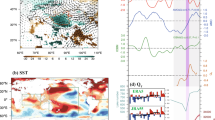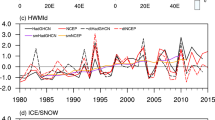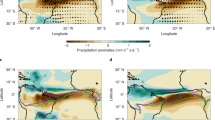Abstract
Climate projections for the twenty-first century suggest an increase in the occurrence of heat waves. However, the time at which externally forced signals of anthropogenic climate change (ACC) emerge against background natural variability (time of emergence (ToE)) has been challenging to quantify, which makes future heat-wave projections uncertain. Here we combine observations and model simulations under present and future forcing to assess how internal variability and ACC modulate US heat waves. We show that ACC dominates heat-wave occurrence over the western United States and Great Lakes regions, with ToE that occurred as early as the 2020s and 2030s, respectively. In contrast, internal variability governs heat waves in the northern and southern Great Plains, where ToE occurs in the 2050s and 2070s; this later ToE is believed to be a result of a projected increase in circulation variability, namely the Great Plain low-level jet. Thus, greater mitigation and adaptation efforts are needed in the Great Lakes and western United States regions.
This is a preview of subscription content, access via your institution
Access options
Access Nature and 54 other Nature Portfolio journals
Get Nature+, our best-value online-access subscription
$29.99 / 30 days
cancel any time
Subscribe to this journal
Receive 12 print issues and online access
$209.00 per year
only $17.42 per issue
Buy this article
- Purchase on Springer Link
- Instant access to full article PDF
Prices may be subject to local taxes which are calculated during checkout





Similar content being viewed by others
References
Wolfson, N. & Atlas, R. A simple diagnostic tool for the investigation of persistent phenomena with applications to the summer 1980 U.S. heat wave. Atmos. Ocean 24, 111–127 (1986).
Meehl, G. A. & Tebaldi, C. More intense, more frequent, and longer lasting heat waves in the 21st century. Science 305, 994–997 (2004).
Karl, T. R. & Knight, R. W. The 1995 Chicago heat wave: how likely is a recurrence? Bull. Am. Meteorol. Soc. 78, 1107–1119 (1997).
Schär, C. et al. The role of increasing temperature variability in European summer heat waves. Nature 427, 332–336 (2004).
Dole, R. et al. Was there a basis for anticipating the 2010 Russian heat wave? Geophys. Res. Lett. 38, L06702 (2011).
Trenberth, K. E. & Fasullo, J. T. Climate extremes and climate change: the Russian heat wave and other climate extremes of 2010. J. Geophys. Res. 117, D17103 (2012).
Hoerling, M. Anatomy of an extreme event. J. Clim. 26, 2811–2832 (2013).
IPCC Climate Change 2007: Mitigation of Climate Change (eds Metz, B., Davidson, O. R., Bosch, P. R., Dave. R. & Meyer, L. A.) (Cambridge Univ. Press, 2008).
Duffy, P. B. & Tebaldi, C. Increasing prevalence of extreme summer temperatures in the US. Climatic Change 111, 487–495 (2012).
Kharin, V. V., Zwiers, F. W., Zhang, X. & Wehner, M. Changes in temperature and precipitation extremes in the CMIP5 ensemble. Climatic Change 119, 345–357 (2013).
Karl, T. R. & Quayle, R. P. The 1980 summer heat wave and drought in historical perspective. Mon. Weather Rev. 109, 2055–2073 (1981).
Jones, B. & et al. Future population exposure to US heat extremes. Nat. Clim. Change 5, 652–655 (2015).
Kim, O.-Y., Wang, B. & Shin, S.-H. How do weather characteristics change in a warming climate? Clim. Dynam. 41, 3261–3281 (2013).
Cattiaux, J., Douville, H., Schoetter, R., Parey, S. & Yiou, P. Projected increase in diurnal and interdiurnal variations of European summer temperatures. Geophys. Res. Lett. 42, 899–907 (2015).
Schneider, Tapio., Bischoff, Tobias. & Płotka, Hanna. Physics of changes in synoptic midlatitude temperature variability. J. Clim. 28, 2312–2331 (2015).
Screen, J. A. Arctic amplification decreases temperature variance in northern mid- to high-latitudes. Nat. Clim. Change 4, 577–582 (2014).
Palmer, T. N. Climate extremes and the role of dynamics. Proc. Natl Acad. Sci. USA 110, 5281–5282 (2013).
Shepherd, T. G. Atmospheric circulation as a source of uncertainty in climate change projections. Nat. Geosci. 7, 703–708 (2014).
Teng et al. Projected intensification of subseasonal temperature variability and heat waves in the Great Plains. Geophys. Res. Lett. 43, 2165–2173 (2016).
Kirtman, B. P. & Power, S. B. in Climate Change 2013: The Physical Science Basis (eds Stocker, T. F. et al.) Ch. 11 (IPCC, Cambridge Univ. Press, 2014).
Ruff, T. W. & Neelin, J. D. Long tails in regional surface temperature probability distributions with implications for extremes under global warming. Geophys. Res. Lett. 39, L04704 (2012).
Petoukhov, V., Rahmstorf, S., Petri, S. & Schellnhuber, H. J. Quasiresonant amplification of planetary waves and recent Northern Hemisphere weather extremes. Proc. Natl Acad. Sci. USA 110, 5336–5341 (2013).
Monahan, A. H., Fyfe, J. C., Ambaum, M. H. P., Stephenson, D. B. & North, G. R. Empirical orthogonal functions: the medium is the message. J. Clim. 22, 6501–6514 (2009).
Poli, P. et al. ERA-20C: an atmospheric reanalysis of the twentieth century. J. Clim. 29, 4083–4097 (2016).
Kay, J. E. The Community Earth System Model (CESM) large ensemble project: A community resource for studying climate change in the presence of internal climate variability. Bull. Am. Meteorol. Soc. 8, 1333–1349 (2015).
Taylor, K. E., Stouffer, R. J. & Meehl, G. A. An overview of CMIP5 and the experiment design. Bull. Am. Meteorol. Soc. 93, 485–498 (2012).
Sardeshmukh, D. P., Compo, G. P. & Penland, C. Need for caution in interpreting extreme weather statistics. J. Clim. 28, 9166–9187 (2015).
Tollefson, J. The case of the missing heat. Nature 505, 276–278 (2014).
Solomon, S. et al. The persistently variable 'background' stratospheric aerosol layer and global climate change. Science 333, 866–870 (2011).
Clement, A. & DiNezio, P. The tropical Pacific Ocean—back in the driver’s seat? Science 343, 976–978 (2014).
Karl, T. R. et al. Possible artifacts of data biases in the recent global surface warming hiatus. Science 348, 1469–1472 (2015).
Deser, C., Knutti, R., Solomon, S. & Phillips, A. S. Communication of the role of natural variability in future North American climate. Nat. Clim. Change 2, 775–779 (2012).
Hawkins, E. & Sutton, R. Time of emergence of climate signals. Geophys. Res. Lett. 39, L01702 (2012).
Wallace, J. M., Deser, C., Smoliak, B. V. & Phillips, A. S. in Climate Change: Multidecadal and Beyond (ed. Chang, C.-P.) 1–29 (World Scientific Series on Asia-Pacific Weather and Climate Vol 6, World Scientific, Singapore 2013).
Deser, C., Phillips, A. S., Alexander, M. A. & Smoliak, B. V. Projecting North American climate over the next 50 years: uncertainty due to internal variability. J. Clim. 27, 2271–2296 (2014).
Barnes, E. A. & Screen, J. A. The impact of Arctic warming on the midlatitude jet stream: Can it? Has it? Will it? WIREs Clim. Change 6, 277–286 (2015).
Coumou, D., Lehmann, J. & Beckmann, J. The weakening summer circulation in the Northern Hemisphere mid-latitude. Science 348, 324–327 (2015).
Koster, R. D. et al. Regions of strong coupling between soil moisture and precipitation. Science 305, 1138–1140 (2004).
Fischer, E. M., Rajczak, J. & Schär, C. Changes in European summer temperature variability revisited. Geophys. Res. Lett. 39, K19702 (2012).
Lehmann, J., Coumou, D., Frieler, K., Eliseev, V. & Livermann, A. Future changes in extratropical storm tracks and baroclinicity under climate change. Environ. Res. Lett. 9, 084002 (2014).
Koster, R. D. et al. GLACE: The Global Land–Atmosphere Coupling Experiment. Part I: overview. J. Hydrometeorol. 7, 590–610 (2006).
Seneviratne, S. I. et al. Investigating soil moisture–climate interactions in a changing climate: a review. Earth Sci. Rev. 99, 125–161 (2010).
Walters, C. K. & Winkler, J. A. Airflow configurations of warm season southerly low-level wind maxima in the Great Plains. Part I: Spatial and temporal characteristics and relationship to convection. Weather Forecast. 16, 513–530 (2001).
Wexler, H. A boundary layer interpretation of the low level jet. Tellus 13, 368–378 (1961).
Jiang, X., Lau, N.-C., Held, I. M. & Ploshay, J. J. Mechanisms of the Great Plains low-level jet as simulated in an AGCM. J. Atmos. Sci. 64, 532–547 (2007).
Cook, K. H., Vizy, E. K., Launer, Z. S. & Patricola, C. M. Springtime intensification of the Great Plains low-level jet and Midwest precipitation in GCM simulations of the twenty-first century. J. Clim. 21, 6321–6384 (2008).
Kunkel, K. E. et al. Monitoring and understanding trends in extreme storms: state of knowledge. Bull. Am. Meteorol. Soc. 94, 499–514 (2013).
Janssen, E., Wuebbles, D. J., Kunkel, K. E., Olsen, S. C. & Goodman, A. Observational- and model-based trends and projections of extreme precipitation over the contiguous United States. Earth’s Future 2, 99–113 (2014).
Feng, Z. et al. More frequent intense and long-lived storms dominate the springtime trend in central US rainfall. Nat. Commun. 7, 13429 (2016).
Tang, Y. et al. Future changes in the climatology of the Great Plains low-level jet derived from fine resolution multimodel simulations. Sci. Rep. 7, 5029 (2017).
Cook, K. H., Vizy, E. K., Launer, Z. S. & Patricola, C. M. Springtime intensification of the Great Plains low-level jet and midwest precipitation in GCM simulations of the twenty-first century. J. Clim. 21, 6321–6340 (2008).
Meinhausen, M. The RCP greenhouse gas concentration and their extension from 1765 to 2300. Climatic Change 109, 213 (2011).
Lamarque, J. F. Global and regional evolution of short-lived radiatively-active gases and aerosols in the Representative Concentration Pathways. Climatic Change 109, 191–212 (2011).
Stefanon, M., Fabio, D. & Drobinski, P. Heat wave classification over Europe and the Mediterranean region. Environ. Res. Lett. 7, 014023 (2012).
Smyth, P., Ide, K. & Ghil, M. Multiple regimes in Northern Hemisphere height fields via mixture model clustering. J. Atmos. Sci. 56, 3704–3723 (1999).
Tan, P. N., Steinbach, M. & Kumar, V. Introduction to Data Mining (Addison-Wesley, Reading, MA, 2006).
Acknowledgements
We acknowledge D. Enfield, G. Foltz (NOAA/AOML), E. Johns (NOAA/AOML) and G. Derr (NOAA/AOML) for their comments and suggestions that greatly improved the manuscript. This research was carried out in part under the auspices of the Cooperative Institute for Marine and Atmospheric Studies, a cooperative institute of the University of Miami and the National Oceanic and Atmospheric Administration (NOAA), cooperative agreement NA10OAR4320143. This work was funded by NOAA’s Atlantic Oceanographic and Meteorological Laboratory and by the Climate Observations Division of the NOAA Climate Program Office. S.D. acknowledge funding by NASA grant NNH13AW33I. H.L. acknowledges funding from NOAA Climate Program Office CVP program (GC16-208). S.-K.L. acknowledges funding from NOAA Climate Program Office CVP program (GC16-207). B.P.K. acknowledges funding from the US National Science Foundation (OCE1419569).
Author information
Authors and Affiliations
Contributions
H.L. conceived the study, designed and performed the statistical analysis and wrote the initial draft of the paper. H.L., R.W., S.D., S.-K.L., G.G., B.K. and R.A. contributed to the discussion and interpretation of the results as well as to the writing of the final version of the paper.
Corresponding author
Ethics declarations
Competing interests
The authors declare no competing interests.
Additional information
Publisher’s note: Springer Nature remains neutral with regard to jurisdictional claims in published maps and institutional affiliations.
Supplementary information
Supplementary Information
Supplementary Table 1 and Supplementary Figures 1–14
Rights and permissions
About this article
Cite this article
Lopez, H., West, R., Dong, S. et al. Early emergence of anthropogenically forced heat waves in the western United States and Great Lakes. Nature Clim Change 8, 414–420 (2018). https://doi.org/10.1038/s41558-018-0116-y
Received:
Accepted:
Published:
Issue Date:
DOI: https://doi.org/10.1038/s41558-018-0116-y
This article is cited by
-
Behavior-encoded models reveal differentiated access to public cooling environment by race and income
npj Urban Sustainability (2024)
-
High-elevation snowpack loss during the 2021 Pacific Northwest heat dome amplified by successive spring heatwaves
npj Climate and Atmospheric Science (2023)
-
Delineating and characterizing changes in heat wave events across the United States climate regions
Climatic Change (2023)
-
Strong influence of north Pacific Ocean variability on Indian summer heatwaves
Nature Communications (2022)
-
Growing prevalence of heat over cold extremes with overall milder extremes and multiple successive events
Communications Earth & Environment (2022)



